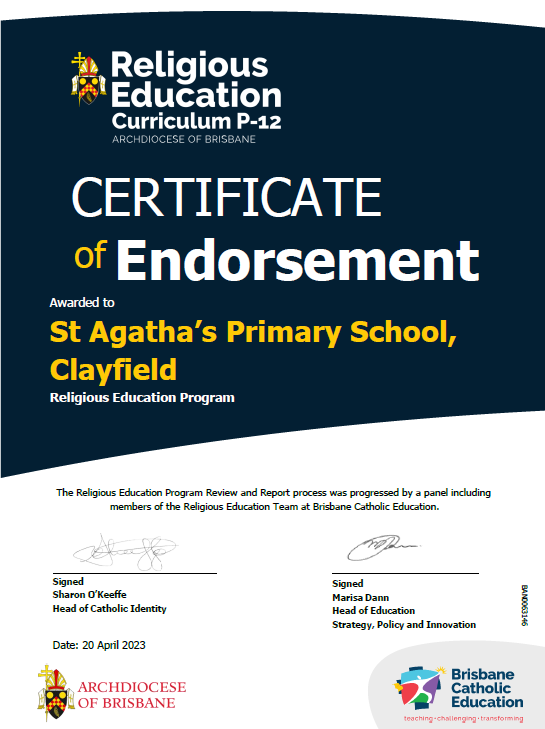Teaching People Religion (Curriculum)
In the schools of the Archdiocese of Brisbane the classroom learning and teaching of Religion aims to develop the religious literacy of students to enable them to participate critically and effectively in the life of their faith communities and the wider society. At St Agatha's we use the Religion Curriculum as approved by the Archdiocese of Brisbane. The Religion Curriculum Prep- Year 12 describes core content that is to be taught and that students should learn, and is therefore the starting point for planning for teaching, learning and assessing of Religion in schools.

The classroom teaching of Religion uses the Archdiocese of Brisbane Curriculum. Catholic schools have an extra 2.5 hours per week in school time for the teaching of religion. This is a subject that is formally accessed.
The content of the Religion Curriculum has been organised into four interrelated strands: Sacred Texts, Beliefs, Church and Christian Life.
Planning for the classroom learning and teaching of religion balances and integrates all four strands as demonstrated through the School Scope and Sequence.
- In Sacred Texts, students become familiar with the Old and New Testaments, learning to understand the authors and intended audiences of these texts. They are assisted to comprehend how the texts relate to modern day living.
- In Beliefs, students learn the significance of Christian and Catholic beliefs and their relevance to contemporary life.
- In Church, children learn to create and engage in a variety of forms of prayer, liturgy and rituals as well as understanding Sacraments of Initiation.
- In Christian Life, students are led to develop moral understanding and reasoning using the Bible as a Catholic guide to moral living.
The full Brisbane Catholic Education Religion Curriculum can be accessed here.
At St Agatha's we Catholic Perspectives (Catholic Social Teachings) also infuse all of areas of the Australian National Curriculum. We believe that: Jesus gives meaning to life and learning; learning is the active, social construction of meaning; and opportunities for learning encompass the richly diverse aspects of all life experience. It is for these reasons that Catholic Perspectives bolster our teaching of the Australian National Curriculum. Examples of Catholic Perspectives across the curriculum can be found here and clicking on the blue cross of each learning area.
In particular a Catholic Perspective plays an important role in the teaching of Relationships and Sexuality Education within the Australian National Curriculum's Health and Physical Education teaching and learning. The intension of Relationships and Sexuality Education is to empower young students to advocate for, and effectively participate in:
- Personal safety and ongoing transformation
- Enriching the lives of all others
- Cultivating loving just and safe communities
An example of the Year 3 and 4 Australian National Curriculum – Health and Physical Education states students should 'identify and practice strategies to promote health, safety and wellbeing'. A Catholic Perspective on this particular part of the curriculum would further include that 'spiritual practices such as prayer, scripture, reflection, mindfulness, meditation and contemplation serve to cultivate calm and perspective leading us more deeply into awareness of and connection to God, self, and others'.
Fundamentally, Relationships and Sexuality Education with a Catholic perspective focuses 'upon the lifelong journey toward wholeness, from egoism to self-giving love as a person created in the image of God and one who contributes to the common good'. Further information for parents can be found here.
© Brisbane Catholic Education, St Agatha's Primary School (2023)
© Brisbane Catholic Education, (2023)